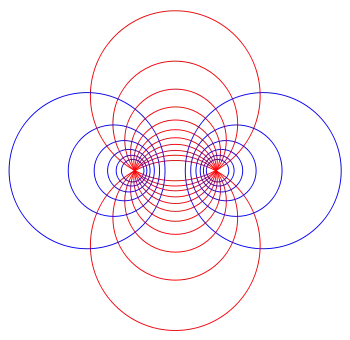Toroidal coordinates
Toroidal coordinates are a three-dimensional orthogonal coordinate system that results from rotating the two-dimensional bipolar coordinate system about the axis that separates its two foci. Thus, the two foci and in bipolar coordinates become a ring of radius in the plane of the toroidal coordinate system; the -axis is the axis of rotation. The focal ring is also known as the reference circle.

Definition
The most common definition of toroidal coordinates is
together with ). The coordinate of a point equals the angle and the coordinate equals the natural logarithm of the ratio of the distances and to opposite sides of the focal ring
The coordinate ranges are and and
Coordinate surfaces

Surfaces of constant correspond to spheres of different radii
that all pass through the focal ring but are not concentric. The surfaces of constant are non-intersecting tori of different radii
that surround the focal ring. The centers of the constant- spheres lie along the -axis, whereas the constant- tori are centered in the plane.
Inverse transformation
The coordinates may be calculated from the Cartesian coordinates (x, y, z) as follows. The azimuthal angle is given by the formula
The cylindrical radius of the point P is given by
and its distances to the foci in the plane defined by is given by

The coordinate equals the natural logarithm of the focal distances
whereas equals the angle between the rays to the foci, which may be determined from the law of cosines
Or explicitly, including the sign,
where .
The transformations between cylindrical and toroidal coordinates can be expressed in complex notation as
Scale factors
The scale factors for the toroidal coordinates and are equal
whereas the azimuthal scale factor equals
Thus, the infinitesimal volume element equals
Differential Operators
The Laplacian is given by
For a vector field , the Vector Laplacian is given by
Other differential operators such as
and can be expressed in the coordinates by substituting
the scale factors into the general formulae
found in orthogonal coordinates.
Toroidal harmonics
Standard separation
The 3-variable Laplace equation
admits solution via separation of variables in toroidal coordinates. Making the substitution
A separable equation is then obtained. A particular solution obtained by separation of variables is:
where each function is a linear combination of:
Where P and Q are associated Legendre functions of the first and second kind. These Legendre functions are often referred to as toroidal harmonics.
Toroidal harmonics have many interesting properties. If you make a variable substitution then, for instance, with vanishing order (the convention is to not write the order when it vanishes) and
and
where and are the complete elliptic integrals of the first and second kind respectively. The rest of the toroidal harmonics can be obtained, for instance, in terms of the complete elliptic integrals, by using recurrence relations for associated Legendre functions.
The classic applications of toroidal coordinates are in solving partial differential equations, e.g., Laplace's equation for which toroidal coordinates allow a separation of variables or the Helmholtz equation, for which toroidal coordinates do not allow a separation of variables. Typical examples would be the electric potential and electric field of a conducting torus, or in the degenerate case, an electric current-ring (Hulme 1982).
An alternative separation
Alternatively, a different substitution may be made (Andrews 2006)
where
Again, a separable equation is obtained. A particular solution obtained by separation of variables is then:
where each function is a linear combination of:
Note that although the toroidal harmonics are used again for the T function, the argument is rather than and the and indices are exchanged. This method is useful for situations in which the boundary conditions are independent of the spherical angle , such as the charged ring, an infinite half plane, or two parallel planes. For identities relating the toroidal harmonics with argument hyperbolic cosine with those of argument hyperbolic cotangent, see the Whipple formulae.
References
- Byerly, W E. (1893) An elementary treatise on Fourier's series and spherical, cylindrical, and ellipsoidal harmonics, with applications to problems in mathematical physics Ginn & co. pp. 264–266
- Arfken G (1970). Mathematical Methods for Physicists (2nd ed.). Orlando, FL: Academic Press. pp. 112–115.
- Andrews, Mark (2006). "Alternative separation of Laplace's equation in toroidal coordinates and its application to electrostatics". Journal of Electrostatics. 64 (10): 664–672. CiteSeerX 10.1.1.205.5658. doi:10.1016/j.elstat.2005.11.005.
- Hulme, A. (1982). "A note on the magnetic scalar potential of an electric current-ring". Mathematical Proceedings of the Cambridge Philosophical Society. 92 (1): 183–191. doi:10.1017/S0305004100059831.
Bibliography
- Morse P M, Feshbach H (1953). Methods of Theoretical Physics, Part I. New York: McGraw–Hill. p. 666.
- Korn G A, Korn T M (1961). Mathematical Handbook for Scientists and Engineers. New York: McGraw-Hill. p. 182. LCCN 59014456.
- Margenau H, Murphy G M (1956). The Mathematics of Physics and Chemistry. New York: D. van Nostrand. pp. 190–192. LCCN 55010911.
- Moon P H, Spencer D E (1988). "Toroidal Coordinates (η, θ, ψ)". Field Theory Handbook, Including Coordinate Systems, Differential Equations, and Their Solutions (2nd ed., 3rd revised printing ed.). New York: Springer Verlag. pp. 112–115 (Section IV, E4Ry). ISBN 978-0-387-02732-6.